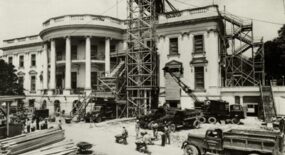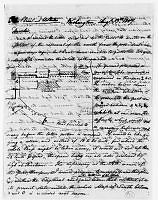
The Historic Decatur House
When Commodore Stephen Decatur, Jr., and his wife, Susan, moved to the new federal city in 1816, they purchased land on the northwest corner of the President’s Park (today's Lafayette Square) with the prize money Decatur was awarded for his naval conquests in the War of 1812. The Decaturs commissioned Benjamin Henry Latrobe, America’s first professional architect and engineer, to design a home “fit for entertaining.” In Washington, Latrobe also designed St. John’s Episcopal Church (better known as the President’s Parish) and parts of the White House.
Built in 1818-1819, the Decaturs' home was the first private residence in the White House neighborhood. Thereafter known as Decatur House, it was a nearly square three-story town house constructed with red brick in the austere Federal fashion of the day. In 1819, the Decaturs moved in with high expectations for the Capital City as well as their own social position. Already a celebrity from his conquests in the Barbary Wars and the War of 1812, Stephen Decatur became one of Washington’s most celebrated figures, and the couple advanced their position by throwing a number of lavish parties in their new house. Unfortunately, the couple only occupied the house for a mere fourteen months as Decatur was mortally wounded in a duel against Commodore James Barron on March 22, 1820.

After Decatur's death, Susan auctioned most of the home’s furnishings, moved to a small house in Georgetown and rented the Decatur House for the next fifteen years to foreign and American dignitaries. Henry Clay, Martin Van Buren, and Edward Livingston made Decatur House the unofficial residences for secretaries of state from 1827 to 1833, each renting the house while they served that post. In addition to housing such prominent political figures in American history, Decatur House was continuously occupied by numerous free and enslaved servants who also played a pivotal role in shaping America. In 1829, Charlotte Dupuy, a women enslaved by Henry Clay, left an indelible mark on the history of Decatur House when she sued Clay for her right to freedom while living in the house.
Due to her overwhelming debt, Susan Decatur was forced to sell the home in 1836. Decatur House was purchased as a retirement home by wealthy hotel and tavern owner John Gadsby, who owned the prestigious National Hotel on Pennsylvania Avenue. He was also well known as the proprietor of Gadsby’s Tavern in Alexandria, leased and operated by Gadsby from 1796 to 1808. The two-story ell built along H Street, N.W. in 1821-1822 for the servants of the tenant, the French minister Baron Hyde de Neuville, later housed many enslaved individuals of the Gadsby household, including three generations of the King and Williams families. It is a rare extant example of urban slave housing in the District of Columbia. After Gadsby’s death in 1844, his wife Providence rented the house to Vice President George M. Dallas and several members of Congress. Her last tenant was Louisiana Senator Judah P. Benjamin. During the Civil War, the federal government seized the building, using it among other things as the Headquarters for the Army Subsistence Department with the main duty of administering the contracts for provisions for the Union army’s ration packs.

General Edward Beale of California purchased the town house in 1871. A frontiersman, diplomat and entrepreneur, Beale was the initiator of the U.S. Army’s Camel Corps in the deserts of New Mexico and Arizona and served as ambassador to Austria-Hungary during the presidency of Ulysses S. Grant. Edward and his wife, Mary, redecorated the house to create a fashionable Victorian home. They installed gas chandeliers and added the impressive parquet floors in the second floor parlors where they frequently hosted social gatherings for Washington’s elite. Upon Edward’s death in 1893, the home remained with his wife Mary; when she died ten years later, it was passed down to their son Truxtun Beale, who had served as ambassador to Persia and Romania. Truxtun and his new wife, Marie One Beale, also did their part to carry on the tradition of entertaining in style as they hosted numerous soirees for diplomats and other prominent Washingtonians.
In 1956, after the home had been in the Beale family for more than 80 years. Marie Beale bequeathed Decatur House and its collection to the National Trust for Historic Preservation. Marie Beale’s generosity not only saved Decatur House but also brought much needed attention to other historic buildings in Lafayette Square which were slated to be demolished to make way for new government office buildings. President John F. Kennedy intervened on this project, and First Lady Jacqueline Kennedy worked with architect John Carl Warnecke to preserve the historic buildings of the park by moving the new office buildings behind them. Decatur House was opened to the public as a museum in the early 1960s.
Established in 2010 and named for David M. Rubenstein in 2011 to recognize his support of the White House Historical Association, the David M. Rubenstein National Center for White House History is located at Decatur House, a National Trust Historic Site owned by the National Trust and operated by the Association. The first of its kind, the center supports research efforts and provide education programs related to the study and history of the White House.
































































